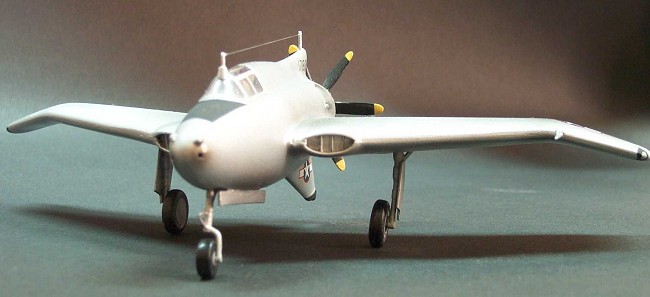
MPM 1/72 XP-56 'Black Bullet'
| KIT #: | ? |
| PRICE: | $ |
| DECALS: | Two options |
| REVIEWER: | Carmel J Attard |
| NOTES: | Short run with resin bits |

| HISTORY |
The XP-56 was built
out of a new construction process known as Heliarc welding, or better known
as TIG welding. It was built out of, then, new material magnesium, which
was welded using a special welding, torch for this process. Tailless in
design configuration the XP-56 also known as “Black Bullet”, was an attempt
to radically improve fighter aircraft performance using
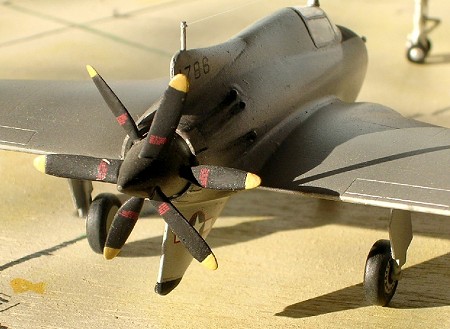 an unconventional,
near all-wing, airframe design. The first prototype flew on the 6th.
September 1943 being powered by a Pratt-Whitney R-2800-29 double Wasp
engine which drove two three-bladed, contra rotating pusher propellers. The
XP-56 was the winner out of three designs that competed for the Army’s
request for Data R-40c document of Nov. 1939. The army specifically
mentioned in R-40c that they would consider aircraft with unconventional
configuration. The other contenders were Vultee who submitted a twin boom
pusher called the XP-54, and Curtiss with the offer of a canard pusher, the
XP-55 Ascender.
an unconventional,
near all-wing, airframe design. The first prototype flew on the 6th.
September 1943 being powered by a Pratt-Whitney R-2800-29 double Wasp
engine which drove two three-bladed, contra rotating pusher propellers. The
XP-56 was the winner out of three designs that competed for the Army’s
request for Data R-40c document of Nov. 1939. The army specifically
mentioned in R-40c that they would consider aircraft with unconventional
configuration. The other contenders were Vultee who submitted a twin boom
pusher called the XP-54, and Curtiss with the offer of a canard pusher, the
XP-55 Ascender.
The XP-56 had a wide
track, tricycle undercarriage. The lateral and directional control was made
by means of a pair of spoilers flush on the upper and lower surfaces of the
drooped wing tips, with pitch control came by means of elevators mounted
inwards of drooped wing tips. The Black Bullet was quite heavily armed with
20 mm cannons and four 0.5 calibre machine guns in the nose. There were two
prototypes, which were built and flew: 41-786 and 41-38353; the latter had
a dorsal fin in addition to the ventral one. The first XP-56 was ready in
April 1943 and was shipped to Muroc Dry Lake (the place which later was
renamed Edwards AFB after the pilot who flew the flying wing bomber YB-49
that was lost with all crew members on it). During the initial ground
handling trials, it was found that the aircraft tended to yaw sharply and
dangerously while taxiing at high speed. It was then thought that faulty
wheel brakes caused this problem. In effect this delayed the first flight
until Sept. 30th 1943, when test pilot John Mayers took the
xp-56 into the air for the first time. During this flight the aircraft
maintained a height of only five feet during which it appeared to fly
normally, which was very encouraging. Nose heaviness was a persistent
problem, and 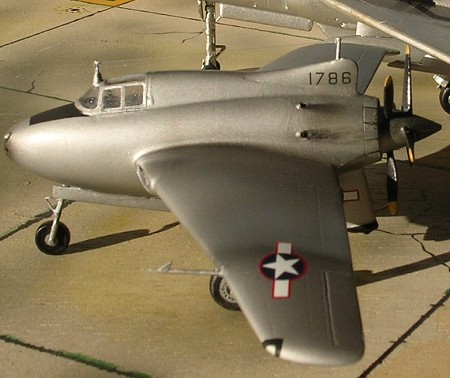 lateral control was difficult to maintain during flight.
Before these problems could be addressed the port main wheel blew out
during a high speed taxiing run and the aircraft somersaulted over onto its
back and was totally wrecked.
lateral control was difficult to maintain during flight.
Before these problems could be addressed the port main wheel blew out
during a high speed taxiing run and the aircraft somersaulted over onto its
back and was totally wrecked.
To correct deficiencies encountered with the first prototype the second XP-56 (42-38353) underwent some major changes. These included a major increase in the upper vertical surface size, fitting a new form of rudder control, and the centre of gravity was moved further forward. On March 23, 1944, test pilot Harry Crosby took the second prototype up for the first time. Crosby found that it was impossible to lift the nose wheel off the ground at speeds below 160 mph and the test flight lasted only a few minutes. In a later flight it was found that the nose wheel problem went away after the landing gear was retracted. Still the aircraft was found to be underpowered for its weight and only low speeds could be attained which was far short from the projected 454 mph at 25000 feet. Further test flight trials were undertaken and on the tenth flight the pilot complained of extreme tail heaviness on the ground, low power, and excessive fuel consumption. The second prototype was finally declared un-airworthy, following unsatisfactory reports of poor handling in the air and too dangerous to continue flight tests with it. Shortly there after the project was abandoned since the age of jet propulsion was nearing the time to bring the era of propeller-driven fighters to a close. The failure of this project however was not a total loss for Northrop learned a lot about flying wing designs where the data gained was put to good use in designs of XB-35 piston engined bomber and YB-49 jet-powered bomber, and the B-2 Stealth bomber!
| THE KIT |
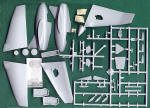 It is not a common choice to have a prototype produced
as an injection moulded kit and the XP-56 Black Bullet was such type. MPM
has produced the kit to a scale of 1/72 and I am glad to see it in view of
its unique shape. There are two colour options, which are an overall silver
colour scheme as the aircraft appeared for the first and second flights in
September 1943. The alternative scheme is for a camouflaged olive drab
upper surfaces and neutral grey lower surfaces which was worn by the Black
Bullet during pre-flight testing and high sped taxi trials conducted five
months prior to first flight.
It is not a common choice to have a prototype produced
as an injection moulded kit and the XP-56 Black Bullet was such type. MPM
has produced the kit to a scale of 1/72 and I am glad to see it in view of
its unique shape. There are two colour options, which are an overall silver
colour scheme as the aircraft appeared for the first and second flights in
September 1943. The alternative scheme is for a camouflaged olive drab
upper surfaces and neutral grey lower surfaces which was worn by the Black
Bullet during pre-flight testing and high sped taxi trials conducted five
months prior to first flight.
| CONSTRUCTION |
This is an interesting aircraft with a unique design which is injection
moulded in light grey plastic with two injection moulded cockpit canopies
included. The fuselage, which was stubby and rounded with its unpressurised
cockpit situated well forward is well represented in two plastic halves
with detailed parts for the cockpit that includes bulkheads, instrument
panel, seats and 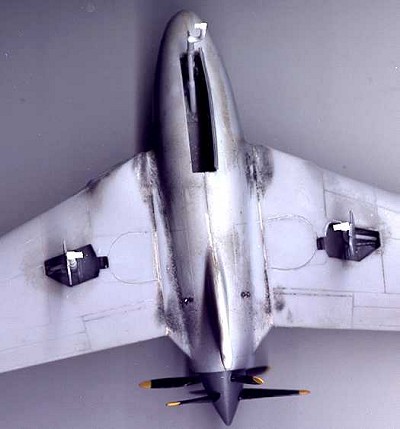 headrest
and also a rollover bar. The short stubby dorsal fin comes in two halves,
which fit, on the fuselage in one piece. The very large ventral fin, which
very nearly scrapes on the ground when the aircraft stood on its landing
gear, is integrally moulded with the two fuselage parts.
headrest
and also a rollover bar. The short stubby dorsal fin comes in two halves,
which fit, on the fuselage in one piece. The very large ventral fin, which
very nearly scrapes on the ground when the aircraft stood on its landing
gear, is integrally moulded with the two fuselage parts.
The cantilever mid-mounted wings come into four main parts and two accurately shaped wing tip components. There are two very intricate shaped air ducts for cooling of the radial engine, which are made of resin and are to be located in the wing leading edge. Each of these have very thin vertical fins which otherwise could not be produced by injection moulded technique. These intake duct details, parts 43 and 44 needs to have the corners that come adjacent to the roots a little proud and therefore are trimmed down not to foul with the two wing parts 38 and 41. The kit also includes two very tiny fairings, also in resin. These are to be mounted on the nose. The position of these could be estimated from the clear photo that comes on the box cover depicting the second prototype during ground trials. There is a slight inaccuracy concerning the landing gear doors mounted under the wing. The bottom plan view on the instruction sheet is showing no inboard landing gear doors. However the shape of the wheel wells, which are covered by the missing doors, is correct on the drawings provided with the kit. Therefore the drawing can be used as a guide to rescribe the shape of the closed doors to replace those incorrectly scribed lines provided in the kit. Like the modern day F-104 and Mirages, the inner doors were open only whilst the landing gear was in transit up or down.
| COLORS & MARKINGS |
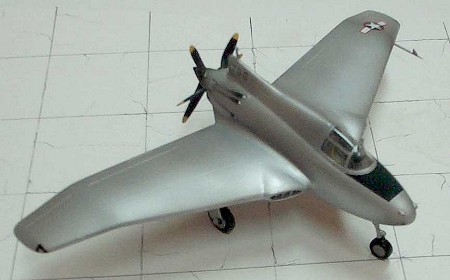 As mentioned earlier there are two colouring options
and hence well-registered decals of high quality are provided for the two
schemes. For the olive/grey aircraft these consist of four stars. The
alternative decal for the overall silver/metal finish XP-56 consists of
four star and bars outlined in red along with a small serial number to go
on the small ventral fin.
As mentioned earlier there are two colouring options
and hence well-registered decals of high quality are provided for the two
schemes. For the olive/grey aircraft these consist of four stars. The
alternative decal for the overall silver/metal finish XP-56 consists of
four star and bars outlined in red along with a small serial number to go
on the small ventral fin.
| CONCLUSIONS |
This was an interesting and unique release by MPM at this scale and shows the extent of prop driven aircraft design and shape before the advent of the jet engine.
| REFERENCES |
War Planes of the Second World War, Fighters Volume 4 by William Green.
November 2005
Copyright ModelingMadness.com. All rights reserved. No reproduction in part or in whole without express permission from the editor.
If you would like your product reviewed fairly and fairly quickly, please contact the editor or see other details in the Note to Contributors.